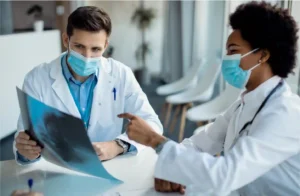

Did you know that over 50% of patients don’t take their medications as prescribed? This alarming statistic, known as medication non-adherence, leads to increased healthcare costs and worse patient outcomes. But what if there was a solution readily available – one that leverages technology and empowers patients to manage their health more effectively?
Thankfully, telehealth is emerging as a powerful tool to tackle these challenges, offering convenient access to care, personalized education, and real-time support, all aimed at bridging the gap in patient compliance with medication.
Simply put, patient compliance refers to how well a patient follows their doctor’s recommendations. This includes taking medication as prescribed, attending appointments, making lifestyle changes, and following any other instructions given for their specific health condition.
It’s crucial because adhering to treatment plans is key to achieving optimal health outcomes. Unfortunately, non-compliance is a major problem, with estimates suggesting nearly half of all patients don’t take their medication as prescribed. This can lead to:
While we’ve discussed the broader concept of patient compliance, medication compliance deserves a deeper dive. Medication compliance refers to strictly following the doctor’s instructions regarding your medication, including:
Feature | Compliance | Adherence |
Definition | Degree to which patient behavior aligns with doctor’s recommendation | Degree to which patient behavior aligns with mutually agreed-upon treatment recommendations |
Power dynamic | Paternalistic: doctor dictates, patient follows | Collaborative: doctor and patient share decision-making |
Patient role | Passive | Active participation and ownership |
Focus | Following prescribed regimen | Following treatment plan tailored to individual needs and preferences |
Barriers | Lack of understanding, forgetfulness, side effects | Lack of understanding, lack of buy-in, communication problems, access issues |
Potential outcomes | Suboptimal health, increased costs, frustration | Improved health outcomes, lower costs, better patient-provider relationship |
Before diving into solutions, let’s explore the reasons behind non-adherence:
Complexity: Multiple medications, varying schedules, and intricate dosing instructions can be overwhelming.
Side effects: Unpleasant side effects can discourage patients from continuing medications.
Cost: Affordability can be a significant barrier, especially for patients with limited resources.
Forgetfulness: Daily routines can get hectic, leading to missed doses.
Lack of understanding: Patients may not fully understand their condition or the importance of their medication.
Fortunately, numerous strategies can help you overcome these challenges and improve your medication adherence:

Fortunately, numerous strategies can help you overcome these challenges and improve your medication adherence:
Talk to your doctor about simplifying your medication schedule if possible. This could involve combining medications, reducing dosing frequency, or switching to longer-acting formulations.
Utilize pill organizers to compartmentalize medications by day and time, making it easier to track and remember doses.
Discuss side effects with your doctor and explore alternative medications or adjustments to your dosage to minimize discomfort.
Utilize over-the-counter medications or natural remedies to manage specific side effects, like ginger for nausea or melatonin for sleep disturbances.
Explore cost-saving options like generic medications, patient assistance programs, or discount cards.
Talk to your doctor about adjusting your medication regimen to fit your budget.
Utilize smartphone apps, alarms, or reminder notes to stay on track with your medication schedule.
Integrate medication-taking into your daily routine, like taking your medication after breakfast or before bed.
Ask your doctor questions about your medications, their purpose, and expected outcomes.
Do your research from reliable sources to understand the benefits and potential risks of your medications.
Telehealth consultations offer convenient access to healthcare professionals who can provide personalized guidance and support regarding medication adherence.
Telehealth platforms can also offer medication reminders, refill services, and educational resources to further enhance your adherence journey.
Inform your family, friends, or healthcare providers about your medication regimen and ask for their support and reminders.
Consider joining online communities or support groups for patients with similar conditions to share experiences and encourage each other.
Remember the days of meticulously writing reminders on sticky notes, meticulously sorting pills into organizers, and still forgetting that crucial dose? Let’s face it, traditional methods for medication adherence often feel like a losing battle.
Telehealth has emerged as a game-changer, offering personalized, convenient, and data-driven tools for your medication compliance.
Gone are generic handouts. Telehealth allows you to connect with healthcare professionals who understand your unique needs and challenges. They can adjust your plan, address concerns, and provide tailored guidance to keep you motivated.
Medication adherence trackers and connected devices monitor your progress in real-time, providing valuable data and insights to both you and your healthcare team. Imagine the peace of mind knowing you’re on top of your regimen!
Telehealth brings healthcare professionals to your living room, making it easier than ever to connect and manage your medication. No more excuses, just convenient access to the support you need.
Telehealth platforms offer engaging educational materials, videos, and even chatbots to make learning about your medication fun and interactive. This boosts your understanding and engagement, making you a partner in your own health journey.
Bridging the gap in patient compliance with medication isn’t just possible, it’s within reach. Telehealth offers a powerful and accessible solution, empowering you to take control of your health with personalized support, convenient access, and data-driven insights. Don’t wait – explore telehealth options, discuss them with your healthcare provider, and start on a journey toward improved medication adherence and optimal health outcomes.
Talk to an Expert Now